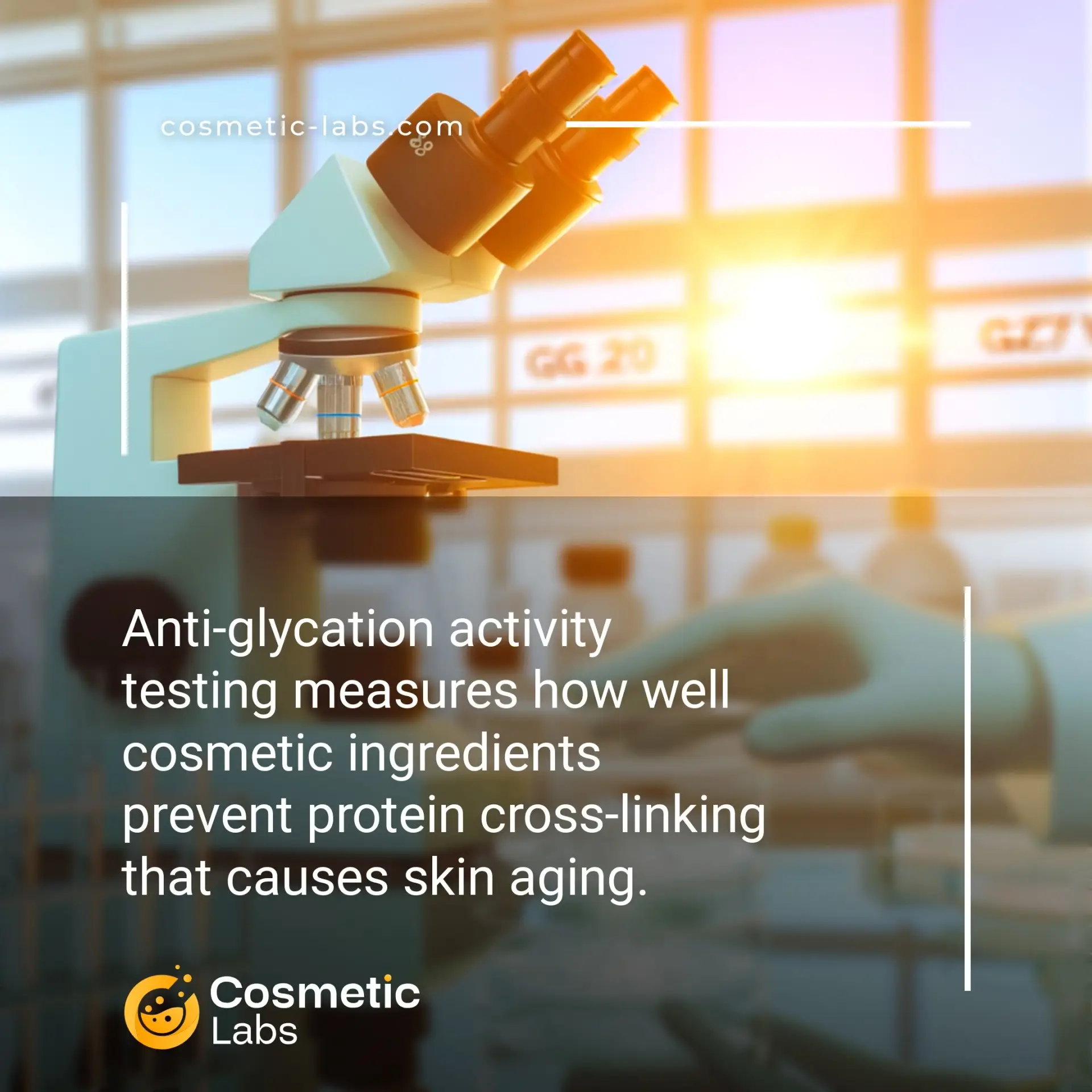Anti-Glycation Testing Services for Anti-Aging Products

What is Anti-glycation activity testing?
Anti-glycation activity testing is a laboratory assay that measures how well cosmetic ingredients prevent glycation—the process where sugars bind to proteins like collagen and elastin, causing skin stiffening and wrinkles. Labs use in vitro models with bovine serum albumin to simulate this aging mechanism, testing ingredient concentrations from 0.1% to 5% against aminoguanidine controls to validate anti-aging claims with quantifiable data.
Why do you need this service?
Beauty brands use anti-glycation testing to validate peptide serums and botanical extracts before launching anti-aging products. Labs measure how ingredients prevent sugar-protein crosslinks that cause skin stiffening and wrinkle formation. This testing helps companies substantiate marketing claims about collagen protection and provides clinical data for regulatory submissions.
Who provides Anti-glycation activity testing services?
All cosmetic labs providing Anti-glycation activity testing services
There is no company providing these services at the moment.
Anti-Glycation Activity Testing for Anti-Aging Products
Anti-glycation activity testing measures how well cosmetic ingredients prevent the formation of advanced glycation end products (AGEs) that contribute to skin aging. This preclinical testing validates your product’s ability to protect collagen and elastin from glycation damage, providing scientific backing for anti-aging claims.
In Vitro Glycation Inhibition Assays
Labs use standardized assays to measure glycation inhibition using bovine serum albumin (BSA) or collagen models. These tests expose proteins to glucose and fructose in the presence of your active ingredients. The formation of fluorescent AGEs gets tracked over 7-14 days at controlled temperatures.
Key testing parameters include:
- Inhibition percentage at different concentrations
- IC50 values for potency comparison
- Dose-response curves for optimal formulation levels
- Stability testing under various pH conditions
Results help you determine effective ingredient concentrations and compare different anti-glycation compounds for your formulations.
Collagen Cross-Linking Prevention Studies
Specialized labs test how ingredients prevent collagen cross-linking using enzymatic assays and fluorescence spectroscopy. These studies measure the protection of collagen’s structural integrity when exposed to glycating agents like methylglyoxal and glyoxal.
Testing protocols examine:
- Collagen fiber organization under glycation stress
- Elastin degradation prevention rates
- Antioxidant activity correlation with anti-glycation effects
This data supports claims about maintaining skin firmness and elasticity. Labs provide detailed reports showing statistical significance and recommended usage levels for regulatory submissions.
Connect with experienced testing laboratories on our platform to validate your anti-aging product’s glycation-fighting capabilities with reliable, reproducible results.
Practical Applications of Anti-Glycation Activity Testing
Anti-glycation activity testing validates ingredient efficacy and product claims for age-defense formulations targeting advanced glycation end products (AGEs) formation.
Ingredient Screening and Validation
Labs screen botanical extracts, peptides, and synthetic compounds for their ability to inhibit protein glycation reactions. Testing protocols measure inhibition percentages against control samples using fluorescence spectroscopy and ELISA-based assays. Results typically range from 15-85% inhibition depending on concentration and mechanism of action.
Brands use this data to select the most potent anti-glycation actives for their formulations. Testing also determines optimal usage concentrations and validates marketing claims about AGE prevention benefits.
Product Development and Claims Support
Finished product testing demonstrates real-world performance of complete formulations rather than isolated ingredients. Labs evaluate how different pH levels, preservatives, and delivery systems affect anti-glycation activity. Testing includes stability studies to confirm activity retention over 12-24 months.
This comprehensive approach supports regulatory submissions and provides substantiated claims data for marketing materials. Brands can confidently communicate specific anti-aging benefits backed by quantifiable test results.
| Testing Method | Primary Application | Typical Timeline | Key Metrics |
|---|---|---|---|
| BSA-Glucose Assay | Ingredient screening | 5-7 days | % Inhibition, IC50 values |
| Collagen Crosslinking | Skin-specific validation | 10-14 days | Crosslink reduction, elasticity |
| Cell-based Models | Mechanistic studies | 14-21 days | Gene expression, protein levels |
| Finished Product Testing | Claims substantiation | 21-28 days | Activity retention, stability |
Ready to validate your anti-aging formulations? Connect with experienced cosmetic labs on our platform to discuss your anti-glycation testing requirements and develop a customized testing strategy for your products.
